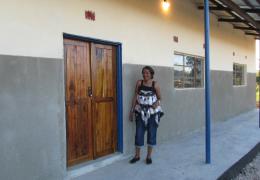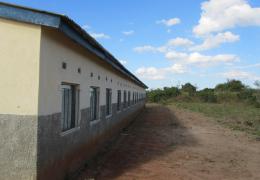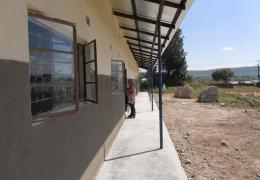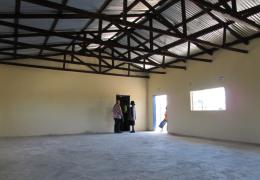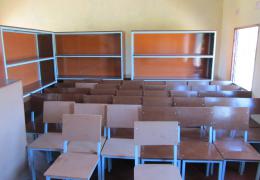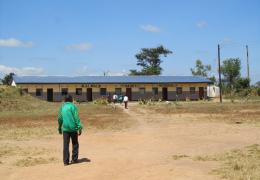The school is ready to start officially. After the classrooms for theoretical lessons also the lab rooms for practical training have been completed (pictures 1, 2, 3 and 4 below). Furniture has been constructed by the school (picture 5). All preparations have been made for the course in Bricklaying and Plastering. The students have made themselves the bricks that are going to be used in classes (photo 3 on the right) and most of the tools have been purchased (picture 6). The final approval from Teveta – the Zambian organization for accreditation of vocational education – is expected shortly.
As is the case with most projects; There are things that go very well, and things that could have gone better. An example of both:
The foundation Joy of a Toy takes care of the orphans in Kalwala Village. For that purpose they set up an orphanage some years ago. Recently a new building with toilets and showers has been added. This was an important step forward in sanitation and hygiene because the building has been supplied with a septic tank. Knowledge on septic tanks was however not available in the region. It had to come from elsewhere. By involving students and teachers of the Trades School in the realization of the septic tank, the knowledge will remain available for future construction projects. For example the concept of septic tanks can be used when building the new staff houses later on this year. Developments like this improve the quality of life in the rural areas. The picture shows the septic tank of the orphanage; the two concrete covers show that the sewage water is cleaned in two phases.
Kalwala Village is situated in a rural area. This kind of areas has typically a low population density. For primary education this is not much of a problem. Small Basic Schools are scattered over the region in such a way that most of the children can reach a school within reasonable walking distance. For secondary education it is different. It is partly because some of the pupils leave the area after Basic School or simply don´t continue their education that numbers decrease. More important however is the fact that secondary education is by its nature more diversified. Roughly speaking there are two forms of secondary education: there is the High School that prepares for tertiary education and there is the Trades School offering a range of vocational training. In rural areas each of the two will be relatively small assuming that the distance from home to the school should not be more than 10 kilometers. Apart from this limited size a characteristic of secondary education is that it requires a diversity of equipment and expertise. The small size and large diversity put pressure on the economy of scale. By having the High School and the Trades School being combined into one single institute – a School for Continuing Education – the utilization of expertise and equipment can be maximized. For obvious reasons this single institute should be under the responsibility of a single ministry, the Ministry of Education. However, the MoE in Zambia is – with a few exceptions – not involved in vocational education. Although a number of functionaries within the field of administration and education have expressed their support for the concept of a School for Continuing Education, and there are a few examples of similar schools elsewhere in the country, up to now a formal approval from the MoE has not been received. Lackson Kwangu, the Headteacher of the Basic School in Kalwala Village, puts a lot of effort in obtaining the formal approval. We appreciate his effort.
The picture below shows (on the left) Mr. Lackson Kwangu who co-ordinates the project on the spot. On the right we see Mrs Ireen Kalwala who was in charge of the construction of the school. in the middle one of the teachers shows what safety clothing the students wear when doing practical training. SOZ would like to take this opportunity to thank specifically Mr Kwangu and Mrs Kalwala for their valuable contribution to the project. Through them SOZ would also like to thank all staff of the school, all workers at the building site and all others involved in the project.
The school is ready to start officially. After the classrooms for theoretical lessons also the lab rooms for practical training have been completed (pictures 1, 2, 3 and 4 below). Furniture has been constructed by the school (picture 5). All preparations have been made for the course in Bricklaying and Plastering. The students have made themselves the bricks that are going to be used in classes (photo 3 on the right) and most of the tools have been purchased (picture 6). The final approval from Teveta – the Zambian organization for accreditation of vocational education – is expected shortly.
As is the case with most projects; There are things that go very well, and things that could have gone better. An example of both:
The foundation Joy of a Toy takes care of the orphans in Kalwala Village. For that purpose they set up an orphanage some years ago. Recently a new building with toilets and showers has been added. This was an important step forward in sanitation and hygiene because the building has been supplied with a septic tank. Knowledge on septic tanks was however not available in the region. It had to come from elsewhere. By involving students and teachers of the Trades School in the realization of the septic tank, the knowledge will remain available for future construction projects. For example the concept of septic tanks can be used when building the new staff houses later on this year. Developments like this improve the quality of life in the rural areas. The picture shows the septic tank of the orphanage; the two concrete covers show that the sewage water is cleaned in two phases.
Kalwala Village is situated in a rural area. This kind of areas has typically a low population density. For primary education this is not much of a problem. Small Basic Schools are scattered over the region in such a way that most of the children can reach a school within reasonable walking distance. For secondary education it is different. It is partly because some of the pupils leave the area after Basic School or simply don´t continue their education that numbers decrease. More important however is the fact that secondary education is by its nature more diversified. Roughly speaking there are two forms of secondary education: there is the High School that prepares for tertiary education and there is the Trades School offering a range of vocational training. In rural areas each of the two will be relatively small assuming that the distance from home to the school should not be more than 10 kilometers. Apart from this limited size a characteristic of secondary education is that it requires a diversity of equipment and expertise. The small size and large diversity put pressure on the economy of scale. By having the High School and the Trades School being combined into one single institute – a School for Continuing Education – the utilization of expertise and equipment can be maximized. For obvious reasons this single institute should be under the responsibility of a single ministry, the Ministry of Education. However, the MoE in Zambia is – with a few exceptions – not involved in vocational education. Although a number of functionaries within the field of administration and education have expressed their support for the concept of a School for Continuing Education, and there are a few examples of similar schools elsewhere in the country, up to now a formal approval from the MoE has not been received. Lackson Kwangu, the Headteacher of the Basic School in Kalwala Village, puts a lot of effort in obtaining the formal approval. We appreciate his effort.
The picture below shows (on the left) Mr. Lackson Kwangu who co-ordinates the project on the spot. On the right we see Mrs Ireen Kalwala who was in charge of the construction of the school. in the middle one of the teachers shows what safety clothing the students wear when doing practical training. SOZ would like to take this opportunity to thank specifically Mr Kwangu and Mrs Kalwala for their valuable contribution to the project. Through them SOZ would also like to thank all staff of the school, all workers at the building site and all others involved in the project.

